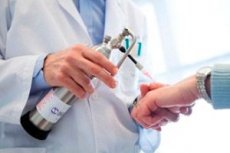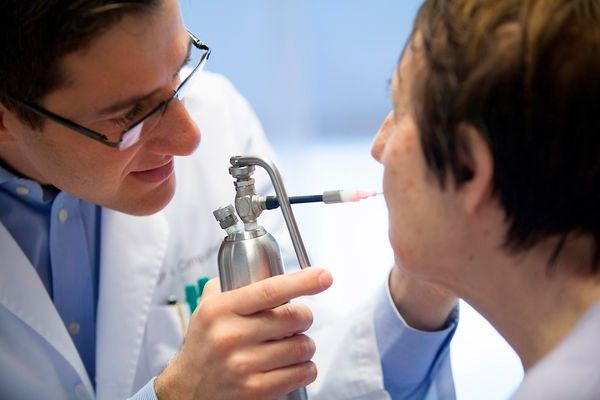Medical expert of the article
New publications
Removal of moles with nitrogen
Last reviewed: 06.07.2025

All iLive content is medically reviewed or fact checked to ensure as much factual accuracy as possible.
We have strict sourcing guidelines and only link to reputable media sites, academic research institutions and, whenever possible, medically peer reviewed studies. Note that the numbers in parentheses ([1], [2], etc.) are clickable links to these studies.
If you feel that any of our content is inaccurate, out-of-date, or otherwise questionable, please select it and press Ctrl + Enter.

Removal of moles (nevi) with nitrogen is freezing of congenital pigment spots with subsequent death. This procedure is performed in many clinics and beauty salons.
Indications for mole removal with liquid nitrogen
Indications for mole removal with liquid nitrogen:
- medical necessity associated with the risk of malignant changes
- large size, injury to the mole when walking, shaving, combing hair
- aesthetic reasons.
The causes of moles have not yet been established (most often they talk about the influence of hormones and genetics). A "healthy" mole is a small cluster of pigment cells, it is symmetrical, with smooth edges, uniform in color, and usually does not bother a person. There are also vascular formations.
But dermatologists emphasize: the condition of the nevus must be monitored regularly and any deviations must be checked by a doctor. Here are these deviations:
- the appearance of crusts, pimples, itching
- increase in size
- a sudden change in color, shape, or convexity
- bleeding
- peeling, itching
- soreness
- skin trauma with moles
- an increase in the number of neoplasms on the body.
Perhaps the doctor will advise to remove it, because a benign formation from quite harmless can turn into malignant. There is a real threat to health and even life of a person.
People with an abundance of skin lesions should always be careful, in particular, do not overuse sunbathing and solariums. Because ultraviolet radiation is contraindicated for nevi and can provoke their enlargement and other changes.
Read also:
Preparation
Preparation for the removal of a mole with nitrogen and the surgical technique depend on several factors. The main one is the location of the nevus: on the surface or deep in the skin. In the first case, a tampon with liquid nitrogen is used, in the second, the same substance is injected with a special needle. Procedures on the face require special precision, so laser technology is used for them (see Laser removal of moles). Of course, only qualified specialists can do this in a medical clinic or hospital.
Nevus removal is performed under local anesthesia, so the patient does not feel pain. A slight tingling or burning sensation is possible.
If one procedure cannot get rid of all the defects, it is easy to repeat it. There are no contraindications or prohibitions to this.
Technique of implementation
The technique for removing moles with nitrogen depends on their location.
When superficially located, a regular tampon with liquid nitrogen is applied to the problematic point. It is kept for a short time (every second counts), strictly ensuring that adjacent or deeper tissues are not damaged.
Another technique is freezing with a thin stream of liquid nitrogen. It is directed vertically, after which the skin turns pale and forms a bubble.
Deep skin formations are much more difficult to eliminate. For this, a special needle is used that penetrates the lower layers. Liquid nitrogen introduced in this way has the desired effect directly on the mole.
Procedures performed on the face require special care - due to the fact that
- the skin here is very thin,
- and the risks of unwanted consequences are high.
To minimize the appearance of postoperative marks and any cosmetic defects in general, laser equipment is used.
How does mole removal with nitrogen occur?
How does nitrogen remove a mole and why does it have a detrimental effect on skin lesions? The essence of the method is to destroy the structure of the mole using ultra-low temperature (in medical terminology - cryodestruction).
A small area of skin with a nevus is frozen to minus 190 degrees; the cold has a detrimental effect on organic tissue, and the damaged epidermis reacts with inflammation and the formation of a blister. It does not fall off, but turns into a protective crust against external factors.
As the skin recovers, the inflammation disappears, the dead tissue is rejected, leaving an almost invisible trace. The procedure is short, painless, and can be repeated if necessary to clean other problem areas. Possible slight discomfort during and after the operation quickly passes.

Important advantages are:
- ease of procedure;
- almost complete absence of unpleasant sensations;
- fairly fast healing;
- low probability of complications.
Contraindications
Before removing skin lesions, it is necessary to make sure that they are benign. Such a conclusion is the competence of a dermatologist or oncologist, who also conduct a special dermatoscopic examination. After cryotherapy, adjacent tissues are examined histologically.
Contraindications for removing moles with nitrogen may be:
- poor quality of education;
- acute skin inflammations;
- infectious skin diseases;
- individual skin intolerance to cold;
- location of formations on the face.
There are folk recipes for getting rid of moles, but according to experts, they are fraught with complications and the formation of scars.
Consequences
The popularity of the cryodestruction method is due, in addition to the simplicity and accessibility of the procedure, to the absence of unwanted consequences, scars or other noticeable marks on the skin.
During the first few days, the site of cryodestruction becomes inflamed, reddens and hardens, and pain or burning may be felt. These are symptoms of a normal healing process. After a week or a week and a half, the crust falls off, revealing young skin underneath. After a month, only a pinkish spot can be seen as a reminder of the mole, which also soon disappears.
Disadvantages and side effects:
- sometimes a repeat procedure is required for full effect;
- When exposed to nitrogen, adjacent areas may be damaged;
- careless handling causes burns;
- healing takes longer than with laser.
Complications after mole removal with liquid nitrogen
Cryodestruction is a rather gentle method and, with a qualified approach, leaves no room for complications. These include:
- special sensitivity of the skin;
- there is a risk of scarring around the problem area;
- formation of a burn due to careless handling and overdose of liquid nitrogen, which leads to an increase in the healing period;
- infection due to damage or premature crusting;
- the appearance of pigment spots or other cosmetic defects.
Usually this method is used only for formations in places hidden by clothing.
Rehabilitation period
The rehabilitation period after removing moles with nitrogen lasts relatively short and largely depends on the individual characteristics of the skin. During this time, you should:
- take proper care of the damaged area;
- treat with an antiseptic (prescribed by a specialist - usually iodine, hydrogen peroxide);
- do not remove the resulting crust;
- after it falls off, protect the young skin with a special cream;
- limit the application of cosmetics;
- Avoid the sun and solarium.
Immediately after cryotherapy, the damaged area is protected with a bandage (plaster) to prevent infection and stimulate regenerative processes.
Care
In the postoperative period after the removal of a mole with nitrogen, specialists focus on caring for the crust. The process should proceed naturally, it cannot be stimulated by cosmetics, water or mechanical procedures. Rejection should occur in due time, without any external influence, because the crust is a barrier to infection, prevention of scar formation.
On the advice of a specialist, you can speed up the regenerative process - with the help of ointments or gels. Care after cryotherapy also includes regular visits to the attending specialist - for examinations and confirmation of successful treatment.
If a mole does not cause any physical or psychological discomfort, it is better not to touch it. If there are indications for removal, you should choose the best method. Removal with liquid nitrogen is one of the quick and effective methods that allows you to cope with the problem.
 [ 3 ]
[ 3 ]

